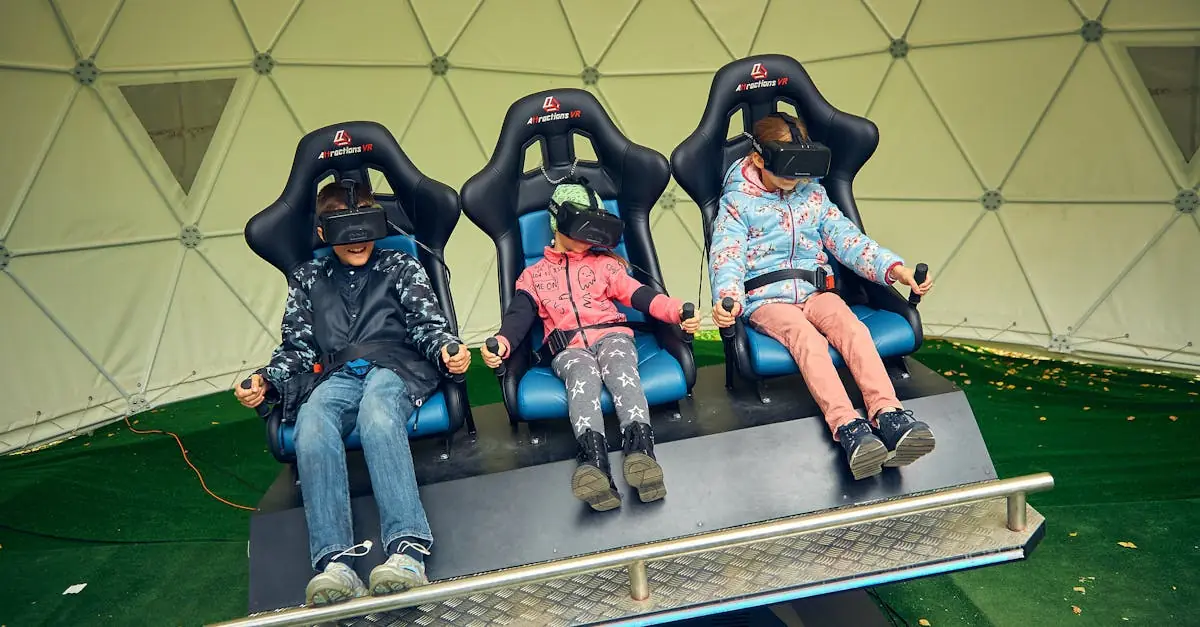Imagine a world where kids can explore the depths of the ocean or soar through the skies without leaving their living room. That’s the magic of virtual reality! It’s not just a fancy gadget; it’s an adventure waiting to happen. With VR, children can dive into immersive experiences that spark their imagination and creativity.
Table of Contents
ToggleOverview of Virtual Reality for Kids
Virtual reality (VR) transforms how children interact with digital environments. It enables them to experience adventures that go beyond traditional gaming. Engaging scenarios range from underwater explorations to outer space missions.
Educational applications benefit from VR, offering interactive lessons in subjects like science and history. Kids can walk through ancient civilizations, observe biological processes, or even conduct virtual experiments. Experiential learning enhances retention and fosters curiosity.
Safety remains a priority when using VR. Parents or guardians should ensure that age-appropriate content is accessed. Several VR platforms provide parental controls to manage experiences effectively.
Physical activity also plays a role in VR usage. Many VR games encourage movement, promoting a more active lifestyle compared to sedentary play. Integration of movement in gameplay helps improve coordination and motor skills.
Social connections benefit from VR environments. Children can interact with peers or join multiplayer games, fostering teamwork and communication. Building relationships in virtual spaces mirrors real-world interactions.
Significantly, research highlights that VR can develop empathy in children. Experiences that place them in different perspectives allow for understanding of diverse viewpoints. This emotional engagement drives compassion and critical thinking.
Overall, virtual reality serves as an innovative tool for childhood development. It combines fun with education, encourages socialization, and nurtures creativity. As technology continues to evolve, VR’s role in children’s lives will likely grow, presenting exciting possibilities ahead.
Benefits of Virtual Reality for Kids
Virtual reality offers numerous benefits that positively impact children’s development and learning.
Enhancing Learning Experiences
Virtual reality engages children in immersive educational environments. Interactive lessons in science stimulate curiosity, enabling kids to explore concepts like ecosystems or space travel. History comes alive when children can walk through ancient civilizations. VR experiences also boost retention rates, as learners remember information better through visual and hands-on activities. Furthermore, specialized programs cater to various learning styles, ensuring that visual, auditory, and kinesthetic learners receive support tailored to their needs. Evidence indicates that VR can significantly improve comprehension in complex subjects by presenting material in an engaging way.
Promoting Creativity and Imagination
Virtual reality unlocks children’s creativity by placing them in fantastical worlds where anything is possible. Kids can invent stories and engage in role-playing adventures that spark their imagination. They manipulate 3D objects and scenes in virtual environments, allowing for artistic expression. Programs dedicated to creative arts let children design their own games or animations, fostering innovative thinking. Additionally, collaborative VR spaces encourage group projects, enhancing teamwork skills. As children create together, they share ideas and build confidence in their creative abilities, establishing a foundation for future endeavors in the arts and other fields.
Risks and Considerations
Virtual reality presents unique risks and considerations for kids. Parents and guardians should remain informed about potential health issues and screen time exposure.
Potential Health Concerns
Using VR equipment can lead to discomfort in children. Symptoms such as dizziness, nausea, or eye strain might occur after prolonged use. Parents should monitor how long their kids engage with VR. The American Academy of Pediatrics suggests regular breaks to minimize fatigue. Some children may experience difficulties adjusting to the immersive experience, which can affect balance and coordination. Keeping an eye on children for any adverse reactions is crucial. Consult a pediatrician if concerns about health arise.
Screen Time Guidelines
Screen time recommendations apply to VR usage. The American Academy of Pediatrics recommends limiting screen time to no more than one hour daily for children aged 2 to 5. For older children, parents should establish consistent boundaries. Setting limits on both VR and other screen experiences encourages healthier habits. Emphasizing physical activity alongside VR can help ensure balance. Scheduling VR sessions can promote responsible usage while still allowing kids to benefit from its educational features.
Popular Virtual Reality Platforms for Kids
Virtual reality platforms specifically designed for kids offer unique opportunities for education and entertainment. These immersive experiences can enhance learning while providing fun.
Educational VR Applications
Educational VR applications engage children in interactive lessons that excite curiosity. Programs like Google Expeditions allow kids to explore historical landmarks or dive deep into the ocean. These applications cater to various learning styles by fostering hands-on activities that improve retention and comprehension. They transform traditional subjects, such as science and history, into memorable adventures. Additionally, VR can present complex topics in a visual format, making it easier for children to grasp challenging concepts.
Entertainment and Gaming VR Experiences
Entertainment and gaming VR experiences captivate children’s imaginations through exciting adventures. Platforms such as Oculus Quest and PlayStation VR feature age-appropriate games that promote physical activity and social interaction. Kids can immerse themselves in virtual worlds, teaming up with friends to solve puzzles or embark on quests. Popular titles like “Beat Saber” and “Minecraft VR” provide interactive gameplay that enhances coordination and encourages cooperative skills. These experiences stimulate creativity while fostering teamwork in a safe environment, enhancing both enjoyment and development.
Virtual reality is reshaping how children learn and play. By immersing them in diverse environments and interactive experiences, it fosters creativity and curiosity. As kids navigate these virtual worlds, they not only enhance their understanding of complex subjects but also develop essential social skills and empathy.
While the benefits are significant, responsible usage is crucial. Parents must monitor screen time and ensure age-appropriate content to safeguard their children’s health. With the right balance, VR can be a powerful tool that enriches childhood development, paving the way for future exploration and creativity. As technology advances, the potential for VR in children’s lives will only expand, offering new adventures and learning opportunities.


